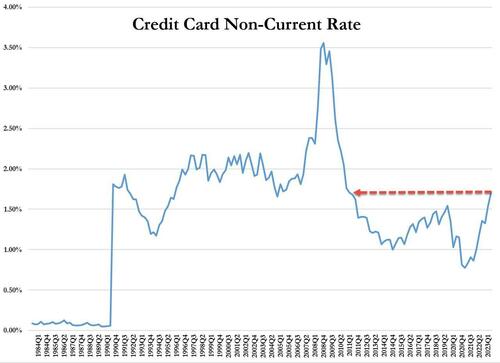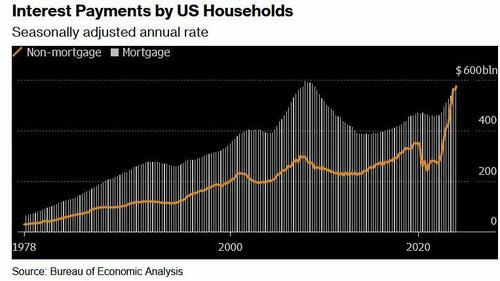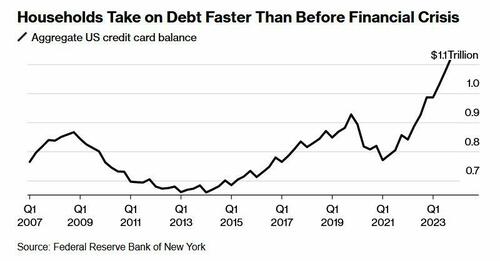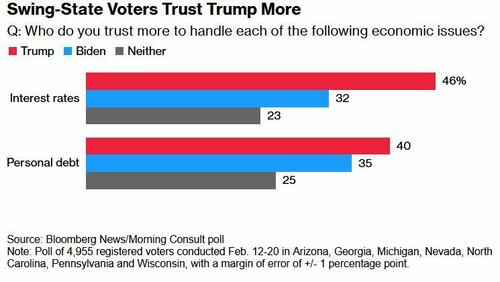“I Can’t Even Save”: Americans Are Getting Absolutely Crushed Under Enormous Debt Load
While Joe Biden insists that Americans are doing great – suggesting in his State of the Union Address last week that “our economy is the envy of the world,” Americans are being absolutely crushed by inflation (which the Biden admin blames on ‘shrinkflation’ and ‘corporate greed’), and of course – crippling debt.
The signs are obvious. Last week we noted that banks’ charge-offs are accelerating, and are now above pre-pandemic levels.
…and leading this increase are credit card loans – with delinquencies that haven’t been this high since Q3 2011.
On top of that, while credit cards and nonfarm, nonresidential commercial real estate loans drove the quarterly increase in the noncurrent rate, residential mortgages drove the quarterly increase in the share of loans 30-89 days past due.
And while Biden and crew can spin all they want, an average of polls from RealClear Politics shows that just 40% of people approve of Biden’s handling of the economy.
Crushed
On Friday, Bloomberg dug deeper into the effects of Biden’s “envious” economy on Americans – specifically, how massive debt loads (credit cards and auto loans especially) are absolutely crushing people.
Two years after the Federal Reserve began hiking interest rates to tame prices, delinquency rates on credit cards and auto loans are the highest in more than a decade. For the first time on record, interest payments on those and other non-mortgage debts are as big a financial burden for US households as mortgage interest payments.
According to the report, this presents a difficult reality for millions of consumers who drive the US economy – “The era of high borrowing costs — however necessary to slow price increases — has a sting of its own that many families may feel for years to come, especially the ones that haven’t locked in cheap home loans.”
The Fed, meanwhile, doesn’t appear poised to cut rates until later this year.
According to a February paper from IMF and Harvard, the recent high cost of borrowing – something which isn’t reflected in inflation figures, is at the heart of lackluster consumer sentiment despite inflation having moderated and a job market which has recovered (thanks to job gains almost entirely enjoyed by immigrants).
In short, the debt burden has made life under President Biden a constant struggle throughout America.
“I’m making the most money I’ve ever made, and I’m still living paycheck to paycheck,” 40-year-old Denver resident Nikki Cimino told Bloomberg. Cimino is carrying a monthly mortgage of $1,650, and has $4,000 in credit card debt following a 2020 divorce.

“There’s this wild disconnect between what people are experiencing and what economists are experiencing.“
CBS: Do you attribute the inflation crisis to the pandemic or Biden?
WISCONSIN VOTER: “It’s been YEARS now since the pandemic — I’m not buying that anymore. At first I did; I’m not buying that anymore because yogurt is STILL going up in price!” pic.twitter.com/apahb65scB
— RNC Research (@RNCResearch) March 15, 2024
What’s more, according to Wells Fargo, families have taken on debt at a comparatively fast rate – no doubt to sustain the same lifestyle as low rates and pandemic-era stimmies provided. In fact, it only took four years for households to set a record new debt level after paying down borrowings in 2021 when interest rates were near zero.
Meanwhile, that increased debt load is exacerbated by credit card interest rates that have climbed to a record 22%, according to the Fed.
[P]art of the reason some Americans were able to take on a substantial load of non-mortgage debt is because they’d locked in home loans at ultra-low rates, leaving room on their balance sheets for other types of borrowing. The effective rate of interest on US mortgage debt was just 3.8% at the end of last year.
Yet the loans and interest payments can be a significant strain that shapes families’ spending choices. -Bloomberg
And of course, the highest-interest debt (credit cards) is hurting lower-income households the most, as tends to be the case.
The lowest earners also understandably had the biggest increase in credit card delinquencies.
“Many consumers are levered to the hilt — maxed out on debt and barely keeping their heads above water,” Allan Schweitzer, a portfolio manager at credit-focused investment firm Beach Point Capital Management told Bloomberg. “They can dog paddle, if you will, but any uptick in unemployment or worsening of the economy could drive a pretty significant spike in defaults.“
“We had more money when Trump was president,” said Denise Nierzwicki, 69. She and her 72-year-old husband Paul have around $20,000 in debt spread across multiple cards – all of which have interest rates above 20%.
During the pandemic, Denise lost her job and a business deal for a bar they owned in their hometown of Lexington, Kentucky. While they applied for Social Security to ease the pain, Denise is now working 50 hours a week at a restaurant. Despite this, they’re barely scraping enough money together to service their debt.
The couple blames Biden for what they see as a gloomy economy and plans to vote for the Republican candidate in November. Denise routinely voted for Democrats up until about 2010, when she grew dissatisfied with Barack Obama’s economic stances, she said. Now, she supports Donald Trump because he lowered taxes and because of his policies on immigration. -Bloomberg
Meanwhile there’s student loans – which are not able to be discharged in bankruptcy.
“I can’t even save, I don’t have a savings account,” said 29-year-old in Columbus, Ohio resident Brittany Walling – who has around $80,000 in federal student loans, $20,000 in private debt from her undergraduate and graduate degrees, and $6,000 in credit card debt she accumulated over a six-month stretch in 2022 while she was unemployed.
“I just know that a lot of people are struggling, and things need to change,” she told the outlet.
The only silver lining of note, according to Bloomberg, is that broad wage gains resulting in large paychecks has made it easier for people to throw money at credit card bills.
Yet, according to Wells Fargo economist Shannon Grein, “As rates rose in 2023, we avoided a slowdown due to spending that was very much tied to easy access to credit … Now, credit has become harder to come by and more expensive.”
According to Grein, the change has posed “a significant headwind to consumption.”
Then there’s the election
“Maybe the Fed is done hiking, but as long as rates stay on hold, you still have a passive tightening effect flowing down to the consumer and being exerted on the economy,” she continued. “Those household dynamics are going to be a factor in the election this year.”
Meanwhile, swing-state voters in a February Bloomberg/Morning Consult poll said they trust Trump more than Biden on interest rates and personal debt.
Reverberations
These ‘headwinds’ have M3 Partners’ Moshin Meghji concerned.
“Any tightening there immediately hits the top line of companies,” he said, noting that for heavily indebted companies that took on debt during years of easy borrowing, “there’s no easy fix.“
Tyler Durden
Fri, 03/15/2024 – 18:00
via ZeroHedge News https://ift.tt/LfQUtDl Tyler Durden








